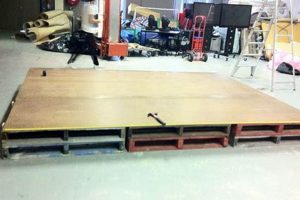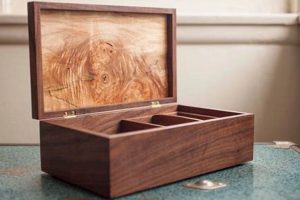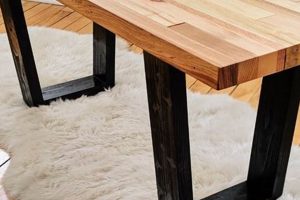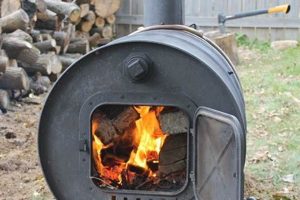Exterior window coverings, crafted at home from lumber, offer a personalized approach to enhancing a building’s facade. These handcrafted elements, typically constructed from readily available materials, provide both aesthetic appeal and functional advantages. For example, individuals might choose to construct louvered or paneled structures using cedar or pine boards, customizing the dimensions and finish to complement the architectural style of their residence.
The advantages of undertaking such a project are multifaceted. Besides the cost savings compared to purchasing pre-made options, these custom-built elements allow for tailored design, ensuring a unique and complementary appearance. Historically, these features provided protection from the elements, controlling sunlight and ventilation. Today, they continue to offer those benefits while adding architectural interest and potentially increasing property value through enhanced curb appeal.
The subsequent sections will address the necessary materials, tools, and techniques involved in the creation of these customized outdoor fixtures, including considerations for design, construction, finishing, and installation. Furthermore, safety protocols and maintenance strategies will be discussed to ensure the longevity and functionality of the finished product.
Construction Considerations for Wooden Outdoor Window Coverings
The following guidelines address key aspects of crafting custom exterior window treatments from timber, focusing on durability, aesthetics, and proper installation.
Tip 1: Material Selection: Opt for wood species naturally resistant to decay, such as cedar, redwood, or pressure-treated pine. These materials exhibit greater longevity when exposed to the elements, minimizing maintenance and extending the lifespan of the structures. For example, cedar contains natural oils that repel insects and resist moisture.
Tip 2: Accurate Measurement: Precisely measure window openings to ensure proper fit and functionality. Undersized components compromise aesthetics, while oversized components impede operation. Employ a reliable measuring tape and double-check all dimensions prior to cutting materials. Consider adding a small reveal for ease of operation.
Tip 3: Proper Joinery: Utilize robust joinery techniques, such as mortise and tenon or pocket-hole screws with exterior-grade adhesive, to create durable and weather-resistant connections. Weak joints lead to structural failure and require frequent repairs. Pocket hole joinery should be filled, sanded, and sealed correctly to avoid water damage.
Tip 4: Adequate Sealing: Apply multiple coats of high-quality exterior primer and paint or stain to protect the wood from moisture, UV radiation, and fungal growth. This protective barrier prevents warping, cracking, and rot. Ensure all surfaces, including end grain, are thoroughly coated.
Tip 5: Secure Mounting: Employ appropriate mounting hardware, such as stainless steel screws or bolts, to securely attach the features to the exterior wall. Improper mounting can result in detachment during high winds or inclement weather. Pre-drilling pilot holes is essential to prevent splitting the wood.
Tip 6: Proper Ventilation: Design the elements to allow for adequate ventilation behind the components. This prevents moisture buildup and minimizes the risk of rot or mildew. Louvered designs inherently provide ventilation; for solid designs, consider incorporating small spacers or standoffs.
Tip 7: Hardware Selection: Select durable, weather-resistant hardware, such as hinges and latches made from stainless steel or powder-coated metal. Inferior hardware will corrode and fail prematurely, compromising functionality and aesthetics.
Adherence to these principles will contribute to the creation of durable, aesthetically pleasing, and functional exterior window treatments that enhance the character and value of the property.
The subsequent sections will elaborate on specific design considerations and provide detailed instructions for various construction methods.
1. Wood Species Selection
The success of any endeavor involving handcrafted exterior window features hinges critically on the selection of appropriate lumber. This initial decision establishes the foundation for long-term durability, aesthetic integrity, and overall performance of these architectural elements. In the context of creating these elements from lumber at home, the choice of material directly impacts resistance to environmental factors, ease of construction, and the eventual maintenance requirements. For instance, employing a softwood such as white pine might simplify the construction process due to its workability; however, its susceptibility to rot and insect infestation necessitates rigorous and frequent treatments to ensure longevity. Conversely, a hardwood like mahogany offers superior resistance to the elements, but presents challenges during construction due to its density and propensity to splitting.
Furthermore, the selected material significantly influences the finish and appearance. Woods like cedar and redwood possess natural oils that enhance their weather resistance and impart a distinctive coloration, often requiring only a clear sealant to highlight their natural beauty. Utilizing these species can minimize the need for extensive painting or staining, saving time and resources. However, if a specific color or finish is desired to match the building’s existing aesthetic, a more neutral wood species, such as poplar, may be a more suitable choice, allowing for greater flexibility in achieving the desired result. Failures in material selection often lead to premature decay, warping, or cracking, necessitating costly repairs or complete replacements. An example includes using untreated pine in a high-moisture environment, which will quickly lead to fungal growth and structural degradation.
In conclusion, the selection of lumber for exterior window treatments constructed at home represents a critical initial step, impacting both the construction process and the long-term performance of the finished product. Understanding the properties of various wood species, considering their inherent resistance to the elements, and aligning the material choice with the project’s aesthetic goals are essential for ensuring the longevity and value of these customized architectural features. Challenges arise in balancing cost, workability, and durability, requiring careful consideration of the specific environmental conditions and the desired lifespan of the construction.
2. Precise Measurements
Accurate dimensioning is paramount in the context of constructing exterior window features from lumber, directly impacting both aesthetic integration and functional performance. Inaccurate measurements frequently lead to misalignment, operational impediments, and a diminished overall appearance. The dimensional stability of wood dictates that even minor inaccuracies can accumulate, resulting in significant discrepancies during assembly and installation. For instance, an eighth-of-an-inch error per component, multiplied across multiple louvers or panel sections, can render the finished construction incompatible with the intended window opening.
The practical implications extend beyond mere aesthetics. Properly dimensioned components ensure smooth operation, preventing binding or sticking during opening and closing. Moreover, precise measurements facilitate secure mounting and attachment to the building’s facade, minimizing the risk of detachment during adverse weather conditions. A real-world example includes exterior window elements designed with insufficient clearance, resulting in paint chipping and wood abrasion each time they are operated. Proper allowance for expansion and contraction, a direct consequence of precise initial dimensions, mitigates these risks and prolongs the lifespan of the installation. These measurements affect the functionality, look and feel of these construction.
In summation, dimensional accuracy is an indispensable element in constructing exterior window features from timber. Its influence spans from initial material preparation to final installation, impacting aesthetics, functionality, and long-term durability. Challenges exist in maintaining precision throughout the various stages of the construction process, underscoring the need for meticulous attention to detail and the use of appropriate measuring tools. This accuracy is also very important to save cost and reduce waste of materials, ensuring that your desired project is a success.
3. Durable Joinery
The structural integrity of exterior window features crafted from lumber is inextricably linked to the employment of durable joinery techniques. As exposed architectural elements, these structures are subjected to constant environmental stressors, including moisture fluctuations, temperature variations, and wind loads. Inadequate joinery precipitates premature failure, necessitating costly repairs or complete replacements. Mortise and tenon joints, for example, offer superior strength compared to simple butt joints secured with nails, owing to their increased surface area for adhesive bonding and mechanical interlocking. This enhanced resistance to shear forces is crucial for maintaining structural stability over extended periods.
The selection of appropriate joinery methods must consider the specific demands placed upon the exterior window features. A frame intended to support heavy louvers requires stronger joints than a purely decorative element. Dowel joints, while suitable for interior applications, often lack the robustness required to withstand the expansion and contraction cycles experienced outdoors. Real-world examples demonstrate the consequences of insufficient joinery: separation of frame components, sagging louvers, and eventual structural collapse. The utilization of exterior-grade adhesives and corrosion-resistant fasteners further enhances the durability of the joinery, mitigating the effects of moisture penetration and preventing degradation over time.
In summary, the longevity and performance of exterior window features crafted from lumber depend significantly on the implementation of durable joinery. Understanding the strengths and weaknesses of various joint types, coupled with the selection of appropriate materials and construction techniques, is essential for creating resilient and aesthetically pleasing architectural elements. The challenges associated with achieving durable joinery underscore the need for careful planning, meticulous execution, and a thorough understanding of wood properties. Ignoring this crucial aspect compromises the entire endeavor.
4. Weather protection
Effective safeguarding against the elements is a critical consideration in the design and construction of exterior window features from lumber. Exposure to moisture, ultraviolet radiation, temperature fluctuations, and wind necessitates robust protective measures to ensure longevity and maintain aesthetic integrity.
- Material Selection and Preservatives
The choice of lumber species directly influences inherent weather resistance. Naturally durable woods like cedar or redwood require minimal chemical treatment, while less resistant species necessitate the application of preservatives. These treatments penetrate the wood fibers, inhibiting fungal growth and insect infestation. Inadequate preservation results in rot, warping, and structural weakening over time. An example is pressure-treated lumber, which is infused with chemicals under pressure for enhanced protection.
- Surface Coatings: Paint and Sealants
Exterior-grade paints and sealants create a protective barrier against moisture penetration and UV radiation. Multiple coats of primer and paint are essential for complete coverage, particularly on end grain, which readily absorbs moisture. Improperly sealed surfaces exhibit blistering, peeling, and eventual wood decay. A common application is the use of oil-based primers to prevent tannin bleed-through from wood species like redwood, which can discolor subsequent paint layers.
- Design Considerations: Water Runoff and Ventilation
Design features that promote water runoff and facilitate ventilation behind the structures minimize moisture accumulation and prevent rot. Sloped surfaces, drip edges, and louvered designs enhance water shedding, while strategically placed gaps or standoffs allow air circulation. Poorly designed elements trap moisture, creating an environment conducive to fungal growth. An illustrative example is the inclusion of a slight overhang on the top edge to deflect rainwater away from the face.
- Hardware and Fastener Selection
The use of corrosion-resistant hardware and fasteners is crucial for preventing rust and degradation, which can compromise structural integrity and create unsightly stains. Stainless steel, brass, or coated fasteners are recommended for exterior applications. Inferior hardware corrodes rapidly, weakening connections and detracting from the overall appearance. The selection of appropriate fasteners, such as screws or bolts specifically designed for exterior use, is essential to prevent premature failure.
These facets underscore the importance of comprehensive weather protection strategies in the creation of exterior window treatments from lumber. A holistic approach, encompassing material selection, surface coatings, design considerations, and hardware selection, ensures long-term durability and preserves the aesthetic value of these handcrafted architectural features. Addressing these elements proactively mitigates the risk of premature degradation and minimizes maintenance requirements.
5. Secure Mounting
The act of affixing exterior window features, constructed from lumber, to a buildings facade necessitates a comprehensive understanding of secure mounting techniques. Improper installation compromises not only the aesthetic value of the work but also poses potential safety risks to occupants and passersby. Secure mounting ensures long-term stability and resistance to environmental stressors, particularly wind loads and gravitational forces.
- Fastener Selection and Load Capacity
The selection of appropriate fasteners, such as screws, bolts, or specialized mounting brackets, must align with the weight and dimensions of the window features, as well as the substrate material of the exterior wall. Insufficient load capacity results in fastener failure, leading to detachment. Real-world examples include the use of inappropriately sized screws in brick facades, resulting in pull-out and subsequent dislodgement of the features during high winds.
- Wall Anchors and Substrate Considerations
Different exterior wall substrates, such as wood siding, brick, or stucco, require specific anchoring systems to ensure secure attachment. Wall anchors distribute the load across a wider surface area, preventing point-loading and substrate damage. Installing into crumbling brick without proper anchoring, for instance, provides minimal holding power and jeopardizes the stability of the installation.
- Proper Spacing and Alignment
The spacing and alignment of mounting points significantly influence the overall stability of the features. Evenly distributed mounting points minimize stress concentrations and prevent warping or twisting. Misaligned fasteners create undue stress, accelerating wear and increasing the risk of failure. Unevenly spaced fasteners can cause a feature to bow over time. Correct alignment is crucial for proper function, particularly for operable units.
- Weather Sealing and Penetration Prevention
Mounting hardware should be installed with appropriate weather sealing to prevent moisture penetration into the wall cavity. Unsealed penetrations lead to water damage, wood rot, and potential structural issues. Caulk or flashing should be used to create a watertight seal around all mounting points. Lack of sealing can lead to significant structural damage. Pre-drilling the holes is a must to prevent splitting the wood parts.
These considerations highlight the critical role of secure mounting in the successful integration of exterior window features constructed from lumber. A systematic approach, encompassing fastener selection, substrate evaluation, proper spacing, and weather sealing, guarantees long-term stability and protects the structural integrity of both the features and the building. Addressing these elements minimizes the risk of failure and maximizes the aesthetic and functional value of the installation. Secure mounting of your DIY project provides longevity and safety.
Frequently Asked Questions
The following questions address common concerns and misconceptions regarding the design, construction, and installation of exterior window features created from lumber.
Question 1: What wood species is most suitable for constructing exterior window features in regions with harsh winters?
Wood species exhibiting natural resistance to decay and dimensional stability under fluctuating moisture conditions are optimal. Cedar, redwood, and pressure-treated pine are frequently employed due to their inherent resistance to rot and insect infestation. Additional protective coatings are recommended to mitigate the effects of prolonged exposure to snow and ice.
Question 2: How can warping be minimized in exterior window features constructed from solid lumber?
Warping can be mitigated through several strategies. Seasoning the lumber properly to reduce moisture content before construction is crucial. Employing joinery techniques that resist racking forces, such as mortise and tenon, strengthens the overall structure. Applying multiple coats of a high-quality sealant or paint provides a protective barrier against moisture penetration.
Question 3: What type of fasteners should be used to secure exterior window features to brick or masonry walls?
Expanding anchor bolts or sleeve anchors are recommended for secure attachment to brick or masonry. These anchors provide a strong, reliable hold by expanding within the pre-drilled hole. The selected fasteners must be corrosion-resistant, such as stainless steel or coated steel, to withstand outdoor exposure.
Question 4: How can the lifespan of exterior window features be extended?
Regular maintenance is essential for extending the lifespan of these features. This includes periodic inspections for signs of damage or decay, re-application of protective coatings as needed, and prompt repair of any identified issues. Keeping the surfaces clean and free of debris prevents moisture accumulation and reduces the risk of rot.
Question 5: What design considerations should be taken into account to promote water runoff and prevent moisture accumulation?
Incorporating sloped surfaces, drip edges, and louvered designs facilitates water runoff and minimizes moisture accumulation. Providing adequate ventilation behind the features allows for air circulation, preventing the buildup of condensation and reducing the risk of rot. Designs should avoid creating pockets or areas where water can pool.
Question 6: Are permits required for installing exterior window features constructed from lumber?
Local building codes and regulations vary. It is advisable to consult with the local building department to determine whether permits are required for the installation of exterior window features. Failure to obtain necessary permits can result in fines or mandatory removal of the installation.
These FAQs provide a foundational understanding of key considerations for exterior window treatments constructed from lumber. Adhering to best practices in material selection, construction techniques, and maintenance ensures longevity and enhances the aesthetic appeal of the structures.
The following section will provide a concluding summary of the key points discussed.
Conclusion
This exploration of constructing exterior window features from lumber has underscored the critical factors governing durability, functionality, and aesthetic appeal. Material selection, dimensional accuracy, durable joinery, weather protection, and secure mounting emerge as pivotal elements influencing the longevity and performance of these handcrafted architectural components. Attention to these aspects is paramount for achieving a successful and enduring result.
The commitment to rigorous planning, precise execution, and diligent maintenance will determine the ultimate value and lifespan of these custom-built elements. Diligence in the selection of high-quality materials, coupled with meticulous attention to detail throughout the construction process, ensures the creation of aesthetically pleasing and structurally sound exterior window features that enhance the character and value of the building. Those pursuing such a project should endeavor to prioritize the discussed principles to guarantee a satisfactory and sustainable outcome.


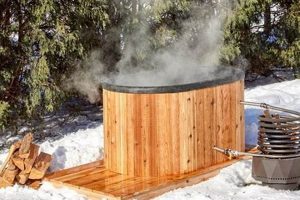
![[DIY Guide] Easy DIY Wood Window Shutters You Can Build! The DIY Hub: Creative Crafts, Repairs & Life Hacks [DIY Guide] Easy DIY Wood Window Shutters You Can Build! | The DIY Hub: Creative Crafts, Repairs & Life Hacks](https://craftingdiycenter.com/wp-content/uploads/2025/07/th-3579-300x200.jpg)
